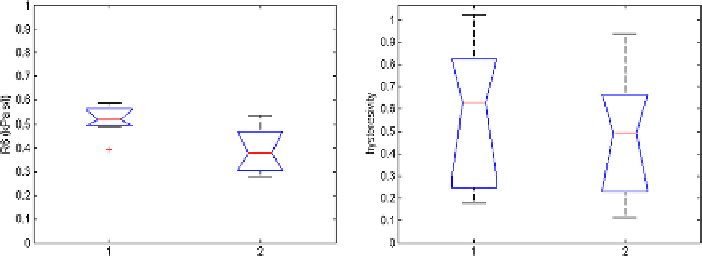Biomedical Engineering Reference
In-Depth Information
Fig. 7.30
Real part of impedance
R
6 evaluated at 6 Hz (
left
) and the tissue hysteresivity
η
r
(
right
)
in
1
: healthy and
2
: cystic fibrosis. See corresponding
p
-values discussed in text
estimates of the mechanical properties of the airways and pulmonary parenchyma
in CF, but in a lower frequency decade than in this present study.
In the 4-48 Hz frequency range, the only parameters able to classify between
healthy and CF children were those derived from the identified impedance at 6 Hz:
R
6,
QF
6, and
PF
6. One should recall that the quality factor
QF
6 is related to the
overall damping factor of the respiratory system, hence indirectly related to
G
r
.
QF
6 was significantly higher in CF than in healthy, denoting an over-damped tissue
property. Consequently, the power factor
PF
6 was below that of healthy children,
suggesting lower efficiency in breathing, thus requiring higher work of breathing.
Although one might expect increased airway resistance in CF than in healthy, the
values for
R
6 were significantly lower in CF than in healthy. One of the reasons
for this result might be that prior to the lung function exam, the CF patients under-
gone removal of retained secretions using specific physiotherapy which resulted in
decreased airway obstruction and overall resistance [
132
].
The lung function measured by spirometry is insensitive to changes in airway
structure, therefore it is not sufficient for early diagnosis of CF. We expect that the
FO4 model is able to capture such changes, but in a lower frequency range.
7.4 Parametric Models for Multiple Resonant Frequencies
7.4.1 High Frequency Range of Respiratory Impedance
Lumped parameter models for the input impedance have been developed for both
low frequency range (0.1-5 Hz) [
31
], as well as in the high frequency range (8-
256 Hz) [
39
], with constant-phase model elements used to model the respiratory
impedance for frequencies below 50 Hz [
56
-
58
].
There is not much information in the literature upon respiratory impedance eval-
uated at frequencies higher than 50 Hz. A possible underlying reason is that vis-
coelastic properties become important at low frequencies and their characteristics

